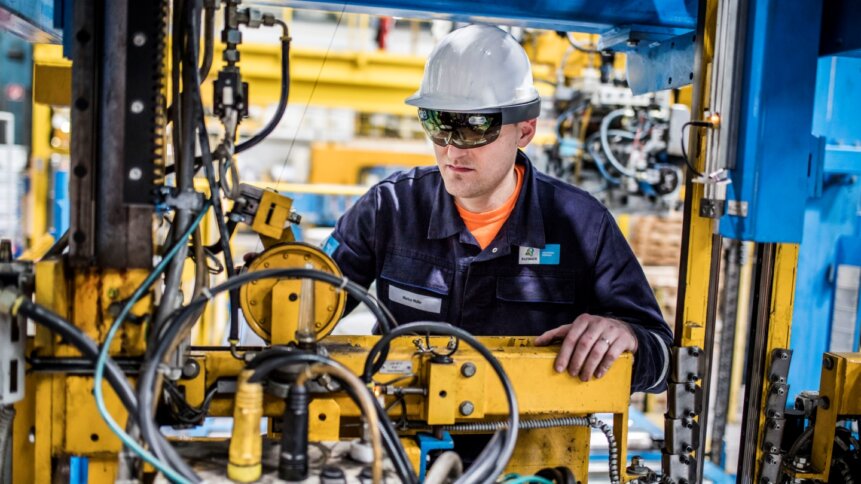Industrial IoT: smart factory KPI survey signals growth

For manufacturers considering industrial IoT, investment in maintenance monitoring comes a close second to capitalizing on automation opportunities. The insight is one of many to be found in a survey – commissioned by Microsoft and Intel – of 500 senior and mid-level managers based in North America (40%), Europe (35%), and Asia-Pacific (25%) regions. Participants were familiar with industrial IoT and had responsibility for digital transformation in the production of automotive, electronics, pharmaceuticals, and other goods. Dubbed ‘IoT Signals: Manufacturing Spotlight‘, the report shines a light on areas where industrial IoT has led to large performance gains and identifies targets for delivering future growth.
Return on investment
Scenarios such as predictive maintenance, which uses smart monitoring to keep downtime and replacement costs to a minimum, continue to pay dividends for smart factory operators even during tough financial markets. Manufacturers look closely at metrics such as return on equity or return on capital employed when considering future investments and IoT-enabled systems that boost the income generated by assets are highly prized.
IoT Analytics, a Germany-based group that worked with Microsoft and Intel in compiling and analyzing data for the report, points to the example of Foxconn. The firm – a maker of electronic devices for big name firms such as Apple, and other well-known brands – has invested in numerous machine sensors at its Shenzhen facility, which allow the performance of production equipment to be logged for analysis. “By aggregating historical data and using AI algorithms, machine failures are predicted well in advance, boosting equipment efficiency by 17%,” writes Philipp Wegner of IoT Analytics.
Monitoring overall equipment effectiveness was seen as either an important or very important key performance indicator (KPI) by more than 86% of experts surveyed. The result shows that while there are many elements that come together to push manufacturing performance to a higher level some markers are stronger than others.
Geographically, North American factories are more likely to have implemented a smart factory strategy, or be in the process of doing so, compared with sites in Europe or Asia. However, adoption rates remain high across the board with at least two-thirds of those surveyed in the Microsoft-Intel study (rising to 80% in North America) responding positively.
Digging a bit deeper into factory KPI figures helps to signpost the enthusiasm that manufacturers have for rolling out IoT across their production lines. Over the past three years, factory KPI’s had improved by 15.3%, based on numbers reported by survey respondents to Microsoft and Intel. And this could just be the beginning of a rewarding trend for adopters. Between now and 2025, operators are forecasting a 66% improvement on the factory KPI growth seen so far.
Cyber savings
Looking ahead, manufacturers point to reducing the number of cybersecurity incidents together with shortening the mean time to detect (MTTD) as two related KPI’s that offer large scope for future improvements in smart factory operations. Other areas include optimizing energy usage, assuming that high supply prices persist, and waste reduction, which has operational as well as design inputs.
There’s more good news too on the theme of sustainability. The survey found that the KPI with the highest increase in ambition is the desire of smart factory leadership to decrease the carbon footprint of their operations. This points to an acceleration in future activity as companies become bound by the combination of tightening environmental legislation and a rising demand from customers for more eco-friendly operations.
Anecdotal evidence suggests that improvements in sustainability might require making KPI’s easier to measure and visualize so that workers on the shop floor can better monitor the environmental consequences of any changes made to production processes (something that emissions calculators can help with).
Feet on the ground
While certainly open to new ideas, the manufacturing sector is necessarily pragmatic and the survey’s authors note that uses of augmented reality and digital twins were at a relatively early stage with projects in proof-of-concept (PoC) or development phases. In terms of future investment, spending was forecast to be above average for digital twins and below average for augmented reality, based on submissions from respondents.
Before any ideas become fully operational they must pass from PoC into pilot schemes, where they’ll be assessed based on a number of parameters – including return on investment – and then rolled out, if the evidence shows that targets can be met. Projects that have moved through this pipeline include cloud-based quality management systems (with 50% of companies surveyed having fully or partially deployed solutions) and AI-based machine vision (39% fully/partially deployed). In contrast, only 20% of respondents were using augmented reality to help guide assembly on a company-wide basis, with most implementations still at a PoC stage.
It’s not just pragmatism that’s a factor – skills gaps can be an issue too, with new technologies such as the use of digital twins to visualize, simulate and predict manufacturing operations. However, as adoption rises, it follows that integration challenges – which are exacerbated by a lack of trained personnel – are likely to ease.











